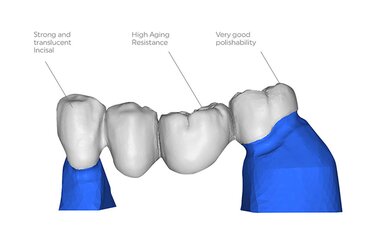These days, zirconia is practically in “everybody’s mouth”. The material has been successfully used in clinical applications for some time now. However, what are the small but subtle differences that distinguishes one material from another?
Zirconium oxide has been praised for its stability ever since it was launched in dentistry. Restorations – especially for the anterior region – are often veneered with a ceramic material to customize them and achieve the desired esthetic effect. However, restorations veneered with glass-ceramics are vulnerable to chipping, particularly if the veneering material has been applied in an excessively thick layer. The incisal areas and cusps are especially exposed to masticatory stresses. The veneering ceramics commonly used today feature a strength of 100 to 200 MPa. This strength is too low to withstand the masticatory stresses, especially if a thick layer of veneering material is present. By comparison, the strength of zirconia is substantially higher than that of conventional veneering ceramics, while offering high translucency and very attractive esthetic properties.
A zirconia material that combines a high-strength zirconium oxide in the dentin area with a highly translucent yet stable zirconium oxide in the incisal area offers the ideal solution: Such a material substantially minimizes the risk of chipping. What is more, the effort required for the manual application and firing of a ceramic veneering material is reduced. And all these advantages come at minimal loss in esthetics.
Tetragonal polycrystalline zirconium oxide features a very high strength and toughness and is therefore suitable for large restorations such as bridges and multi-unit structures that are subject to high mechanical stresses. Cyclic tensile stresses in the area of the connectors and abutment crowns can jeopardize the long-term stability of large restorations in particular. These areas require the high initial strength and fracture toughness of 3Y-TZP.
If such a 3Y-TZP is used in the occlusal area, the conditions of the oral environment, together with cyclic loading, can lead to low-temperature degradation, accompanied by spontaneous formation of monoclinic fraction. This ageing effect and the subsequent increase in surface roughness can occur if the zirconia surface is directly exposed to the oral environment without any protective measures. As the surface roughness of the uppermost layer increases, the wear resistance of the antagonist dentition may be adversely affected.
This risk can be mitigated by increasing the stabilization degree of zirconia. This can be achieved by using a zirconium oxide with an increased stabilization degree in the incisal area. An increased stabilization degree reduces the amount of tetragonal monoclinic fraction, which can form spontaneously. Given the high yttria content of 5 mol-% within this incisal layer, spontaneous formation of monoclinic fraction is minimized. This way, the surface change, or change in roughness, during oral exposure is prevented.
The functional surfaces of monolithic zirconia restorations that come into contact with the opposing dentition must be polished. High-gloss polishing minimizes the wear on the antagonists.
The material combines two zirconia raw materials in a single disc: high-strength 3Y TZP in the dentin area and highly translucent 5Y TZP in the incisal area. This combination provides both impressive esthetics and high strength. IPS e.max ZirCAD Prime provides the right properties exactly where they are needed: It ensures high strength and fracture resistance in the dentin and at the cervical margins of abutment crowns, where the exposure to mechanical stresses is highest, and it provides incisal areas with high translucency, ageing resistance and favourable polishing properties.
Gradient Technology is utilized to achieve a continuous transition between different functional areas. This ensures that no visible sudden changes occur in the material. Especially the material’s continuous gradual progression of translucency towards the incisal is unique compared with the conventional step-by-step increase in other materials.
As a result, IPS e.max ZirCAD Prime offers a universal solution for all processing techniques, from polishing and staining to microlayering and veneering, making it possible to achieve consistent, highly esthetic properties throughout e.g. multi-unit restorations.
